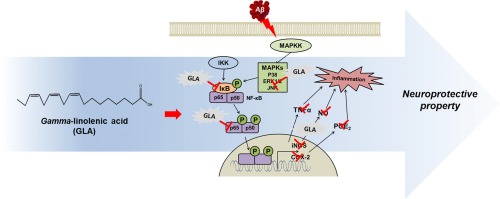Journal of Functional Foods ( IF 3.8 ) Pub Date : 2018-01-10 , DOI: 10.1016/j.jff.2017.12.065 Kumju Youn , Seonah Lee , Mira Jun

|
Beta-amyloid (Aβ) are known to form senile plaques causing neuroinflammation, which was accepted as the major pathological mechanism in Alzheimer’s disease (AD). To elucidate the molecular mechanism of gamma-linolenic acid (GLA) on neuroprotective actions in inflammation, the effect of GLA on Aβ25–35-stimulated in PC12 cells was investigated. Pre-treatment of GLA significantly decreased Aβ25–35-mediated cytotoxicity through the reduction of ROS and downregulation of caspase-3, thereby attenuating apoptotic morphological alteration. GLA inhibited the production of proinflammatory cytokines including TNF-α and PGE2, and further blocked NF-κB subunit p65 activation by suppressing IκB-α degradation. Mechanistic studies revealed that the inhibitory effect of GLA was accompanied by reducing expression of ERK1/2 and JNK activity but not by p38 MAPK. In conclusion, given that GLA prevents the Aβ25–35 damage via NF-κB signaling pathway, all of which may provide an exciting view of the potential application of GLA as a future research for AD.
中文翻译:

γ-亚麻酸通过NF-κB和MAPK信号通路改善Aβ诱导的神经炎症
已知β-淀粉样蛋白(Aβ)形成引起神经发炎的老年斑,这被认为是阿尔茨海默氏病(AD)的主要病理机制。为了阐明在炎症神经保护作用γ-亚麻酸(GLA)的分子机制,GLA对Aβ的影响25-35 PC12细胞刺激的进行了研究。GLA的预处理可通过降低ROS和下调caspase-3来显着降低Aβ25-35介导的细胞毒性,从而减轻细胞凋亡的形态学改变。GLA抑制包括TNF-α和PGE 2在内的促炎细胞因子的产生,并通过抑制IκB-α降解进一步阻止了NF-κB亚基p65的活化。机理研究表明,GLA的抑制作用与降低ERK1 / 2和JNK活性的表达有关,而与p38 MAPK无关。总之,鉴于GLA通过NF-κB信号通路防止了Aβ25-35的损伤,所有这些都可能为GLA作为AD的未来研究的潜在应用提供令人兴奋的观点。











































 京公网安备 11010802027423号
京公网安备 11010802027423号